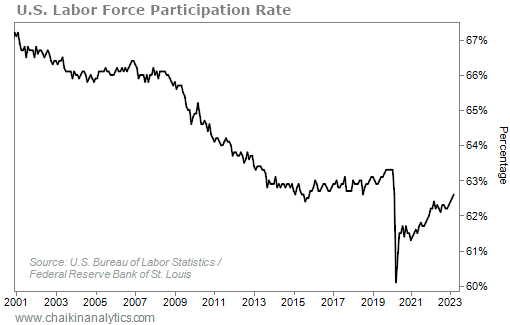U.S. job openings dropped below 10 million for the first time since May 2021…
That might set off some alarm bells in your head at first.
After all, Americans need jobs if they want to buy stuff. And a jobs market with plenty of opportunities gives people leverage to pick the best ones.
That’s good for the economy. It means things are booming.
So on the flip side, it would seem like fewer job openings is a bad thing. Companies don’t hire as much during tough economic times. And the number of opportunities falls.
That’s not always the case…
The U.S. economy has endured a tough few years – from the COVID-19 pandemic to supply-chain issues to high inflation. And almost everyone has experienced the pain in one way or another.
So it makes sense that Americans are paying close attention to economic data today. They’re focused on these reports more than ever before.
But don’t let cherry-picked data frighten you…
A drop in job openings could be alarming on its own. And yet, when we combine that data with another factor, we see that the U.S. labor market is stronger than it seems at first…
Let’s start with the latest data on U.S. job openings…
Every month, the U.S. Bureau of Labor Statistics releases the Job Openings and Labor Turnover Survey – “JOLTS” for short. And last week, it shared the updated numbers…
According to the JOLTS data, the U.S. had roughly 9.9 million job openings in February. That was about 632,000 fewer openings than in January. And it was below Wall Street’s expectations of around 10.4 million.
The following chart shows the JOLTS data since late 2000. Job openings spiked after the COVID-19 pandemic. They reached a peak of more than 12 million in March 2022.
As you can see, the number has decreased since then. Take a look…

But the thing is, one key piece of data is often left out when pundits discuss job openings…
I’m talking about the number of people who are actually working. The U.S. Bureau of Labor Statistics also tracks this data. It’s called the labor force participation rate.
The labor force participation rate is simple to understand. It measures how many people of “working age” are in the workforce at any time. (The “working age” is 15 to 64 years old.)
You can see in the following chart that this number plummeted at the start of the COVID-19 pandemic. Many people lost their jobs as the world came to a standstill.
But folks, the labor force participation rate is climbing today. Take a look…

U.S. job openings are decreasing right now. And the labor force participation rate is increasing at the same time. In other words… more and more Americans are finding work.
That should lead to increased economic productivity in the months and years ahead. And it’s great news for the economy over the long term.
It’s easy to get caught up in the fears of cherry-picked economic data. But remember…
The best buying opportunities often occur when everyone else gets scared. With a contrarian mindset, we can filter through all the noise… buy low… and hold on for the long term.
Keep that in mind today.
Good investing,
Briton Hill